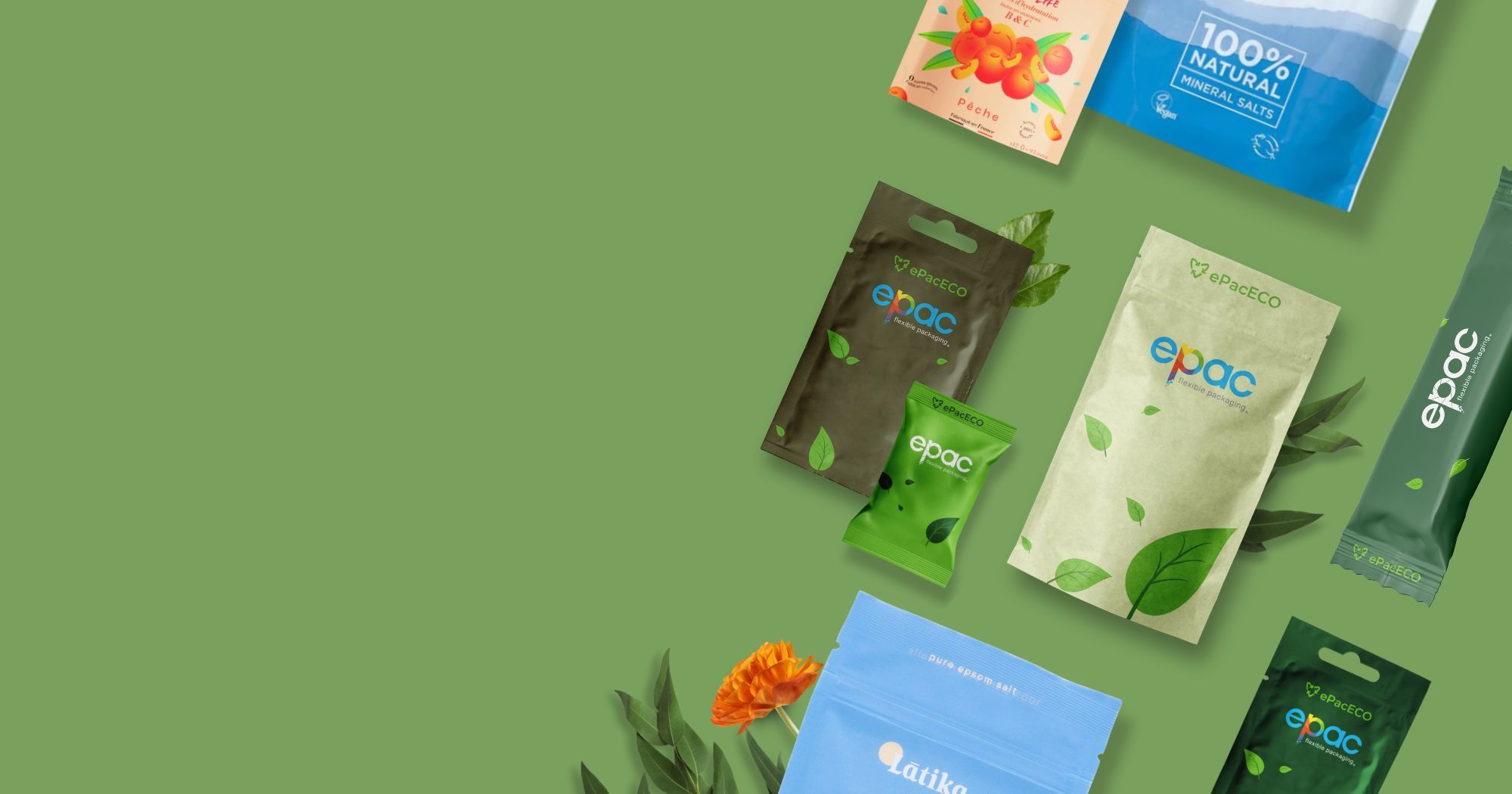
ePac’s Commitment
Why is Our Packaging so Easy to Recycle?
We are uniquely positioned to offer a variety of packaging solutions without compromising product quality and barrier protection.
Our lightweight packaging solutions reduce plastic usage and significantly lower CO2 emissions. Designed for recyclability, our recyclable, mono-material plastic packaging ensures optimal barrier protection while being the easiest to process, contributing to a sustainable future.
With ePacECO, you can trust our products to provide a responsible and eco-friendly alternative to conventional packaging.
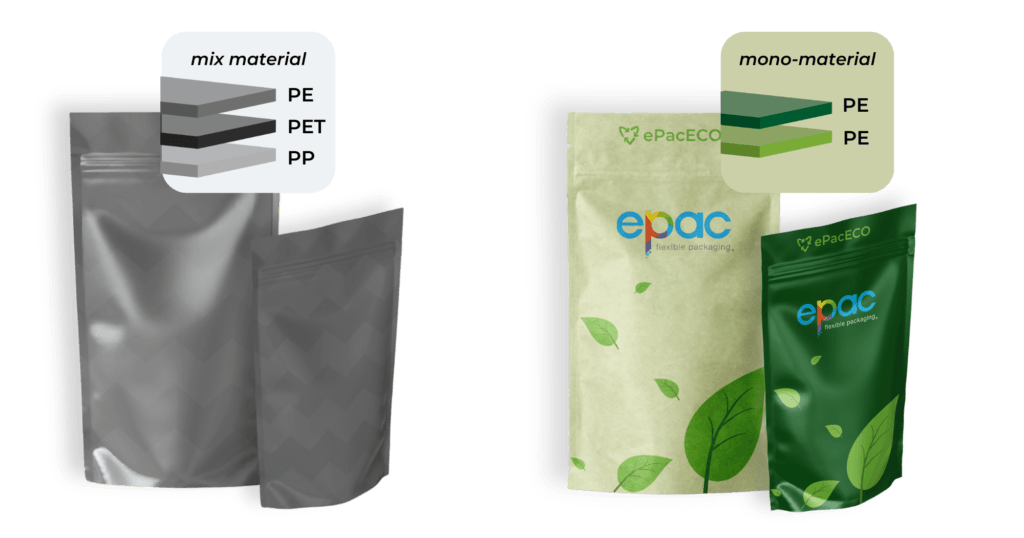

Recyclable

Low CO2 Footprint

Mono-material
structure

Recyclable
Ready

Lightweight
Our ePac EcoLabel not only meets all EU sustainability standards but also aligns perfectly with evolving consumer preferences. You will find this mark proudly displayed on all our ePacECO Label solutions.
Our recyclable options utilise PE and/or PP structures, ensuring they can be recycled wherever collection and recycling systems are in place. For specific details about recyclability in your market, our packaging experts are ready to assist you.
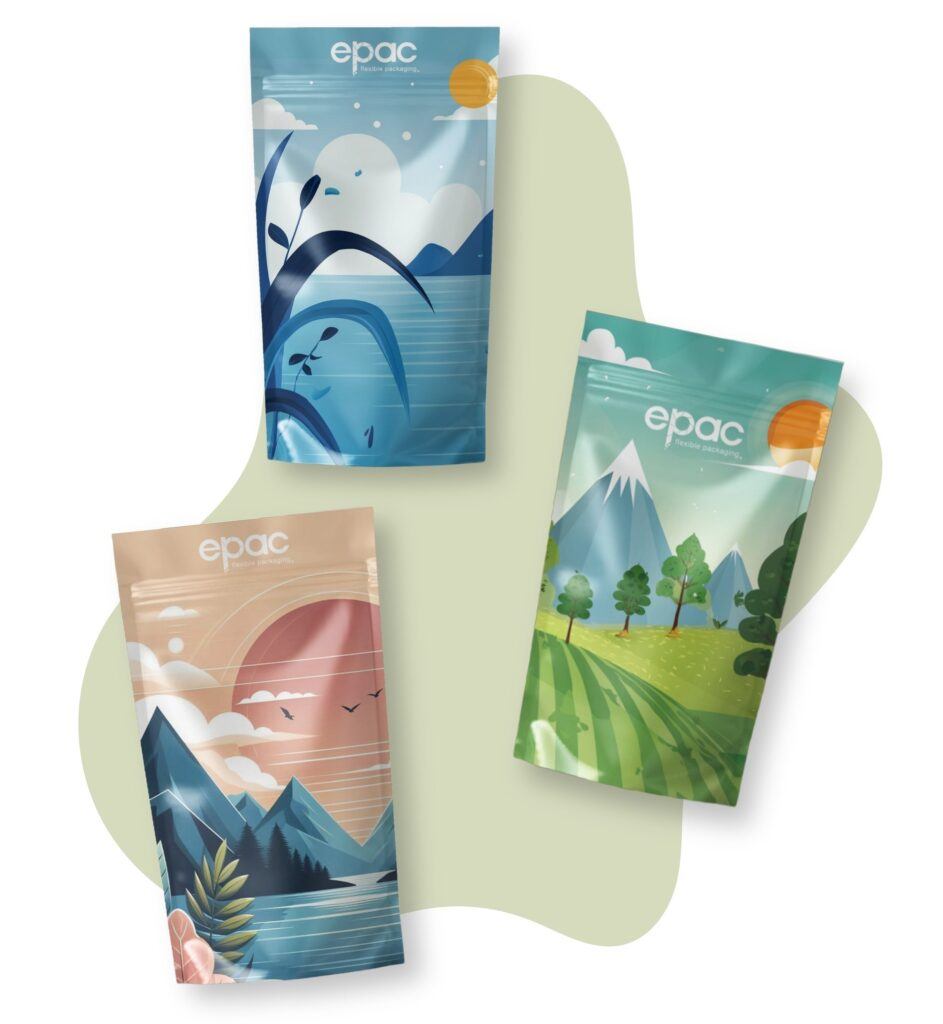
Leading the Way in Recyclable Flexible Packaging
ePac’s R&D efforts are focused on recyclable solutions. We have pioneered the use of mono-material structures, as well as polyolefins, which are increasingly becoming widely recyclable. This allows us to offer our customers sustainable alternatives to their non-sustainable packaging without compromising on shelf life or barrier protection.
Our commitment to innovation keeps us at the forefront of industry trends and ensures compliance with EU legislation. By leveraging our extensive technical expertise and market experience, we guide our customers through the complexities of transitioning to recyclable flexible packaging, helping them stay ahead of the curve.
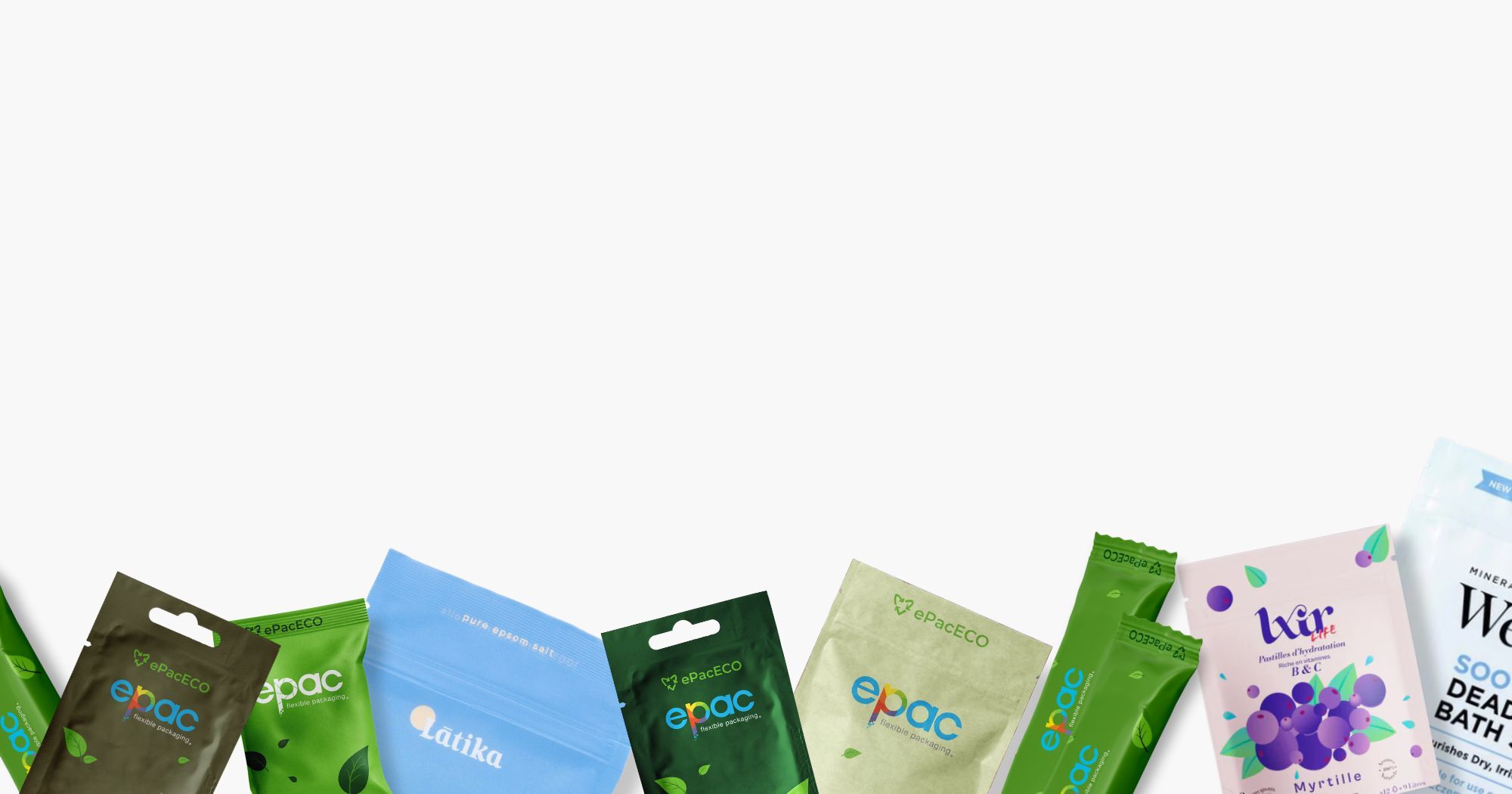
3 steps to a more sustainable packaging



A Packaging Solution for Each Product
STAND UP
Our digitally-printed, custom stand up pouches help your products stand up, and out, on the shelf. Our high-quality films, durable structures, and photo-quality print technology ensure that your pouch has a premium look and feel, matched with best-in-class performance.
Features available
- Press-to-close zipper
- Child resistant zipper
- Straight tear zipper
- Hanghole
- Tear notch
- Rounded Corners
- Window
- Metallic Effect
- Tear notch
- Rounded Corners
- Window
- Metallic Effect
Bottom type
- Plow
- K-seal
- Doyen (Doypack)
Material Finishes
- Gloss
- Matte
- Soft-touch (Satin feel)

LAY FLAT
Our digitally printed lay-flat pouches are made with premium-grade films to help brands of all sizes have a package that stands apart from the competition.
Features available
- Press-to-close Zipper
- Child resistant zipper
- Straight tear zipper
- Hanghole
- Tear notch
- Rounded Corners
- Window
- Metallic Effect
Material Finishes
- Gloss
- Matte
- Soft-touch (Satin feel)

ROLLSTOCK
Easy to run solution for any HFFS and VFFS packing machine lines for this key industry format offering excellent product protection and shelf life.
Perfect for cosmetic, snacks, cheese, single-use coffee sachets, cereal, nutritional bars and many more.
Material Finishes
- Gloss
- Matte


STAND UP
Our digitally-printed, custom stand up pouches help your products stand up, and out, on the shelf. Our high-quality films, durable structures, and photo-quality print technology ensure that your pouch has a premium look and feel, matched with best-in-class performance.
Features available
- Press-to-close Zipper
- Child resistant zipper
- Straight tear zipper
- Hanghole
- Tear notch
- Rounded Corners
- Window
- Metallic Effect
Material Finishes
- Gloss
- Matte
Bottom type
- Plow
- K-seal
- Doyen (Doypack)

LAY FLAT
Our digitally printed lay-flat pouches are made with premium-grade films to help brands of all sizes have a package that stands apart from the competition.
Features available
- Press-to-close Zipper
- Child resistant zipper
- Straight tear zipper
- Hanghole
- Tear notch
- Rounded Corners
- Window
- Metallic Effect
Material Finishes
- Gloss
- Matte

ROLLSTOCK
Easy to run solution for any HFFS and VFFS packing machine lines for this key industry format offering excellent product protection and shelf life.
Perfect for cosmetic, snacks, cheese, single-use coffee sachets, cereal, nutritional bars and many more.
Material Finishes
- Gloss
- Matte
What Our Customers Say
Choosing the right packaging was crucial for Peast Performance’s success. In collaboration with ePac, we opted for 100% recyclable stand-up pouches, aligning with Biologon’s commitment to sustainability and environmentally friendly solutions.
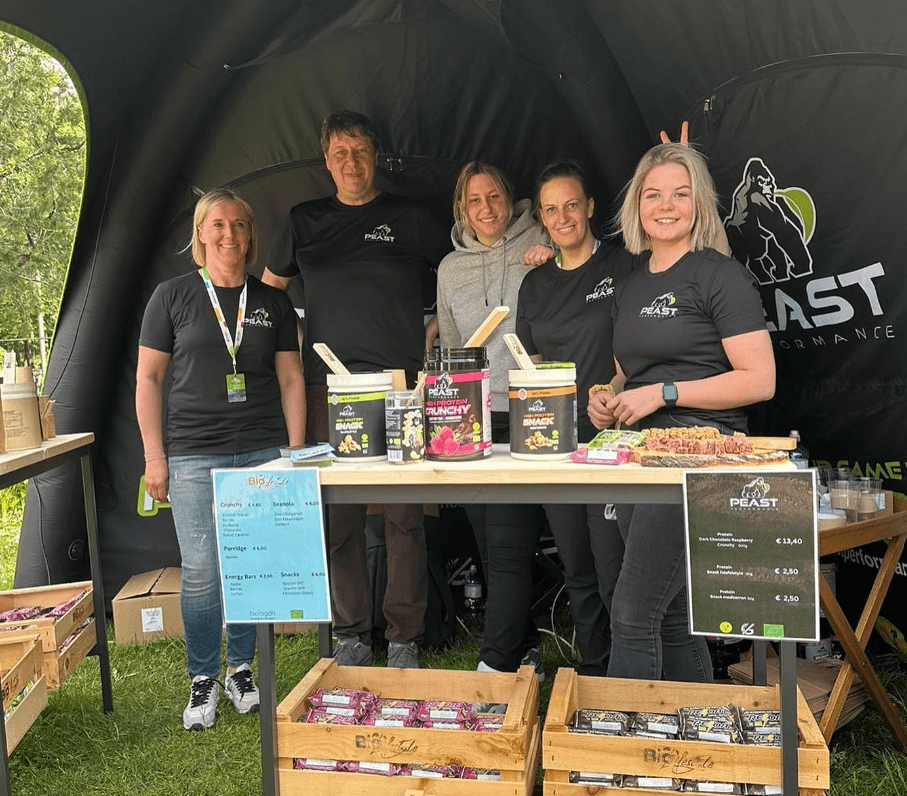
Elsy has opted for recyclable packaging, which can be easily sorted. As a local brand, Elsy proudly embraces the ‘Made in France’ label!.

At Mighty Drinks, we chose recyclable soft plastic packaging to significantly diminish our carbon footprint. The statistics associated with this shift underscore the tangible impact on environmental sustainability, showcasing our dedication to responsible packaging practices.
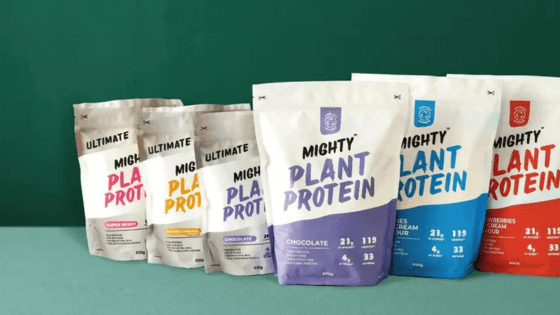
ePac Recyclable Structure by Country*
In Austria, the recyclability of flexible packaging is regulated by the Federal Environment Agency in conjunction with the guidelines of the EU Circular Economy Package. These bodies ensure that packaging materials are designed, labeled, and processed to support a sustainable circular economy.
Below are the recyclable structures we offer in Austria:
| BOPP / BOPP BOPP / PE BOPP / PE EVOH PE / PE PE / PE EVOH |
| BOPP / METBOPP / PE BOPP / METBOPP PE / METBOPP / PE |
In France, the recyclability of flexible packaging is overseen by Citeo and Cotrep, two key advisory bodies dedicated to promoting sustainable packaging and recycling practices. These organisations provide guidelines and standards to ensure that packaging materials are designed for efficient recycling.
In France, our recyclable structures include:
| PE / PE PE / PE EVOH |
| Paper / PE EVOH |
In Germany, the recycling of flexible packaging is governed by the Verpackungsgesetz (Packaging Act) and monitored by the Verpackungsregister (Packaging Register). These regulatory frameworks ensure that packaging materials are designed, labeled, and processed to promote effective recycling and environmental sustainability.
At ePac Flexible Packaging, we are committed to providing sustainable packaging solutions that align with Germany’s stringent recycling standards. Here is a detailed list of our recyclable structures available in Germany:
| BOPP / BOPP BOPP / PE BOPP / PE EVOH PE / PE PE / PE EVOH |
| BOPP / METBOPP BOPP / METBOPP / PE PE / METBOPP / PE |
| PE / PE |
| PE / PE EVOH |
In the UK, the recycling landscape for flexible packaging is guided by key advisory bodies such as the On-Pack Recycling Label (OPRL) and the Advisory Committee on Packaging (ACP). These organizations provide crucial guidelines and standards to ensure that packaging materials are correctly labeled and recycled efficiently.
Here’s a breakdown of our recyclable packaging structures available in the UK:
| PE / PE PE / PE EVOH BOPP / PE BOPP / PE EVOH BOPP / BOPP |
| PE / METBOPP / PE BOPP / METBOPP BOPP / METBOPP / PE |
* The recyclability information provided is based on the latest PPWR regulations as of June 2024 and may vary by country.




